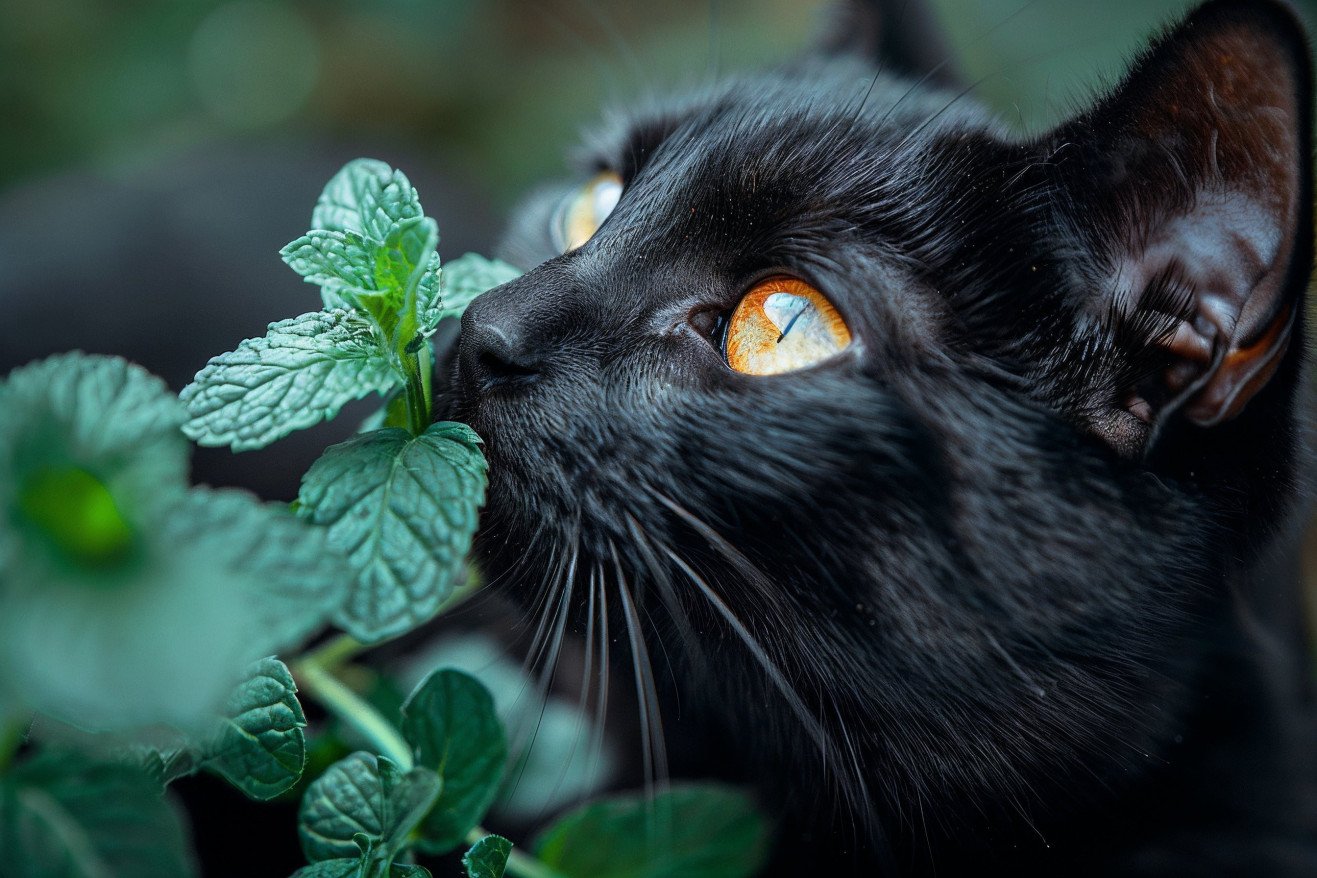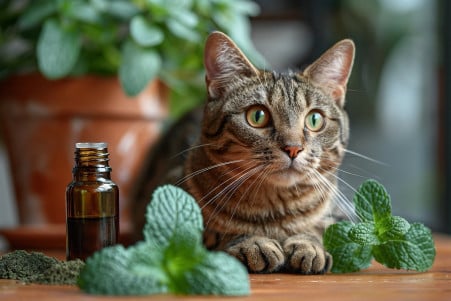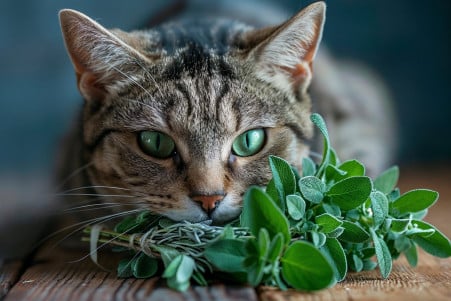Can Cats Eat Mint? Here's What the Experts Have to Say
8 April 2024 • Updated 8 April 2024

Is it OK for your cat to eat mint? While it's safe for cats to consume in small amounts, it can lead to digestive upset and other health issues if ingested in large quantities. Plus, cats are typically averse to the smell of mint. So, while it's not poisonous, you should probably avoid giving your cat mint to eat.
Although there's plenty of anecdotal evidence on both sides of the issue, we'll cover the research conducted by veterinary professionals and animal nutritionists to help you determine whether or not you should let your cat eat mint. By examining the chemical composition of mint, the way cats' bodies work, and the experiences of other cat owners and veterinarians, you'll be able to decide whether or not you want to let your cat eat this aromatic herb.
Is mint bad for cats?
Mint Toxicity in Cats: Signs, Symptoms, and First Aid
The signs of mint toxicity in cats can vary widely from mild to severe. According to the pet care experts at WagWalking, common signs of mint poisoning in cats include vomiting, diarrhea, lethargy, weakness, and ataxia. More seriously, VCA Animal Hospitals cautions that ingestion of mint can result in liver failure or central nervous system depression.
Cats with pre-existing liver, kidney, or digestive issues are more likely to experience complications from mint poisoning. This is because, as the Pet Poison Helpline explains, cats lack a key liver enzyme that is necessary to effectively metabolize a variety of toxins, including the essential oils found in mint.
If you think your cat has ingested mint, it is important to seek immediate veterinary care to ensure that your pet receives the care they need and to prevent further complications. First aid steps should include identifying the type of mint your cat has ingested, watching for signs of poisoning, and calling a veterinarian or pet poison control center for advice.
Although mint may not be especially toxic, its essential oils can be dangerous, especially for cats with pre-existing health conditions. Knowing the signs of mint poisoning and seeking help when you notice them can help ensure that your cat gets the care they need and doesn’t experience any long-term problems.
Types of Mint: Toxic and Nontoxic to Cats
Not all types of mint are equally toxic to cats. While garden mint and sweet mint are generally considered nontoxic, they can still lead to an upset stomach if eaten in large amounts, according to information on the toxicity of mint to cats. Meanwhile, peppermint, pennyroyal, and some essential oils made from mint are considered to be extremely toxic and even potentially lethal to cats.
Mint in its concentrated form, such as essential oils or extracts, is more toxic than the plant itself. Cats are attracted to the smell of mint because it contains nepetalactone, a chemical that’s also found in catnip. However, cats’ bodies don’t have the enzymes necessary to break down certain chemicals in mint, which can lead to toxicity.
Knowing the different levels of toxicity of various types of mint can help cat owners decide which kinds to keep away from their pets and which ones are OK to let their pets be around in small amounts. This information is important for ensuring that your home is safe for your cat, as you’ll learn in the next section.
How to Avoid Mint Exposure: Keeping Cats Safe and Healthy
The most effective way to avoid mint poisoning in cats is to ensure that all mint plants and mint products are kept well out of their reach. Homes with cats should avoid using essential oil diffusers, potpourri, and other concentrated mint products since the oils are especially toxic. If you are growing mint plants, you can use cat-proof planters or fencing to keep cats away from the plants.
To help cats satisfy their natural urges, offer safe, cat-friendly options like catnip, cat grass, or rosemary. Keep a close eye on cats for any signs of mint consumption, since it’s important to get them to the vet right away if they show any symptoms. By taking these steps, cat owners can ensure that their cats are safe and healthy.
By following these steps, cat owners can enjoy the benefits of mint and other herbs while ensuring that their cats are safe from harm. The next section will cover how to create a cat-friendly herb garden that uses safe, non-toxic options.
How to Make a Cat-Friendly Herb Garden: Safe Mint Alternatives
For cat owners who love to garden, there are plenty of non-toxic herbs that can be grown in place of mint. As noted by Season Herbs, some of the most popular options are catnip, basil, cat grass, and cat thyme, all of which can help cats in a variety of ways, from providing mental stimulation to aiding in digestion.
When creating a cat-friendly herb garden, it's important to make sure that the plants are in well-draining pots and that they are rotated to avoid overcrowding, as suggested by Life On Virginia Street. In addition, any plants that could be toxic to cats should be kept separate from the area where the cat-friendly plants are grown to ensure that cats can't accidentally eat them.
As pointed out by Found Animals, it's also important to make sure that cats are supervised when they are first introduced to new plants and to keep an eye out for any signs of allergies or sensitivities. By doing so, cat owners can ensure that they can garden to their heart's content while also providing a safe and enriching environment for their cats.
The next section will take a look at other common household plants that can be toxic to cats, underscoring the importance of maintaining a safe indoor environment.
Other Houseplants to Avoid: How to Keep Your Cat Safe Indoors
Mint isn’t the only plant that can be toxic to cats – many other common houseplants can also pose a risk. For example, Preventive Vet warns that lilies, sago palms, and some types of ivy can all be toxic to cats and cause serious illness or death if they’re ingested.
That’s why it’s important to research the toxicity of any new houseplants before bringing them into a home with cats. As Preventive Vet suggests, if you have any toxic plants in your home, either replace them with a cat-safe option or make sure they’re in a place where your cat can’t get to them.
In addition, make sure to regularly check your cat for signs of plant ingestion and, if you notice any symptoms, get them to the vet right away, as recommended by Cats Protection. By making sure your home is safe and cat-friendly, you can help ensure that your cat doesn’t accidentally ingest a toxic plant and stays healthy and happy.
Conclusion: How to Protect Your Cat and Keep Them Healthy
While mint is not inherently toxic to cats, it can cause digestive issues and discomfort if consumed in large quantities. Catster explains that a cat would have to eat a lot of mint to reach a toxic level, as the essential oils in mint are the most problematic. Fortunately, cats are more likely to nibble on mint leaves, which would not come close to a toxic level.
However, essential oils and extracts are more concentrated and therefore more dangerous, and should be kept away from cats, as Kritter Kommunity points out. This is because cats lack the liver enzymes needed to metabolize and excrete the concentrated compounds.
By taking the necessary precautions, offering safe alternatives, and knowing the signs of mint toxicity, cat owners can make sure their pets stay safe and healthy. Life On Virginia Street's DIY cat herb garden project is a great example of how to create a cat-friendly environment with non-toxic plants.
With the right information and preventive steps, cat owners can enjoy the benefits of mint and other herbs while ensuring their cats are safe.


